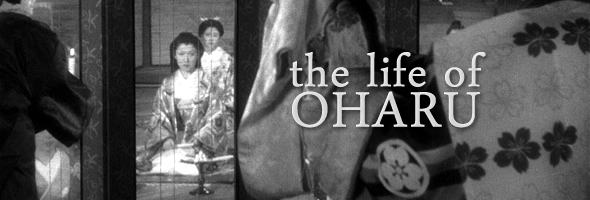
B&W, 1952, 136m.
Directed by Kenji Mizoguchi
Starring Kinuyo Tanaka, Tsukie Matsuura, Ichirô Sugai, Toshirô Mifune, Toshiaki Konoe
Criterion (Blu-Ray & DVD) (US RA/R1 HD/NTSC), Artificial Eye (UK R2 PAL)
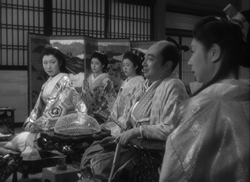 Perhaps best known today for such masterpieces as Ugetsu and Sansho the
Perhaps best known today for such masterpieces as Ugetsu and Sansho the 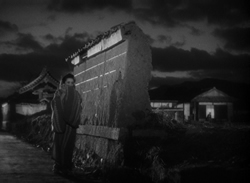 Bailiff, director Kenji Mizoguchi was one of several Japanese filmmakers who broke through to Western audiences thanks to his incisive ability to depict human behavior and the havoc wreaked on women by inequality.
Bailiff, director Kenji Mizoguchi was one of several Japanese filmmakers who broke through to Western audiences thanks to his incisive ability to depict human behavior and the havoc wreaked on women by inequality.
One of his finest films, The Life of Oharu, tackles the subject of women's place in society head on by opening at a low point for Oharu (Tanaka, a Mizoguchi regular), a Kyoto prostitute who, at the age of fifty, can't compete with her younger peers and suffers the derisive scorn of her few clients. In flashbacks at a temple she reflects on the past three decades that led to her current state, starting with her youth as an imperial lady in waiting and daughter of a respected samurai (Sugai). However, she falls for a lowly page (Mifune, two years before Seven Samurai), which not only ends (very) badly but forces her into exile. Her father betrays her trust and pawns her off as a concubine for a wealthy lord (Konoe) whose wife can't bear a son, but even that plan doesn't work out as planned. From there it's a difficult path through 17th century Japan involving a convent, a marriage to a kindly fan manufacturer, a brothel, and one final ironic twist of fate.
Given the 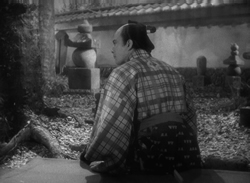 title and subject matter, it would be natural to expect a soap opera showing a woman sacrificing all and paying dearly on her way to the grave. However, Mizoguchi's approach turns out to be a bit more indirect, focusing on Oharu's internal struggle rather than lingering on the physical gauntlets she has to run over the years. The ending is a bit different from what would normally be
title and subject matter, it would be natural to expect a soap opera showing a woman sacrificing all and paying dearly on her way to the grave. However, Mizoguchi's approach turns out to be a bit more indirect, focusing on Oharu's internal struggle rather than lingering on the physical gauntlets she has to run over the years. The ending is a bit different from what would normally be 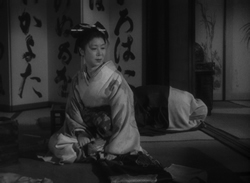 expected as well, avoiding a typical tragic resolution in favor of something more complex and, in the end, probably realistic.
expected as well, avoiding a typical tragic resolution in favor of something more complex and, in the end, probably realistic.
Mizoguchi has become a familiar name among Criterion Collection fanatics in recent years thanks to the releases of the previously mentioned films along with the solid Eclipse collection, Kenji Mizoguchi's Fallen Women. This marks their second of his films to get the Blu-Ray treatment in America (following Sansho the Bailiff), though the UK has also chipped in with a four-title set from Artificial Eye and a special edition of Ugetsu. Artificial Eye also released an earlier Region 2 DVD of Life of Oharu, but the Criterion easily outpaces it with an impressive 1080p transfer that admirably recreates the texture of watching a film print. There's some unavoidable age-related damage during the opening credits and occasionally to a much lesser degree during the film, but the vast majority of it looks excellent. Given the often perilous condition of many Japanese titles from this era, it's a pleasure to see this one faring so well into the next century. The LPCM Japanese mono soundtrack sounds very good considering the limited nature of the source, while the optional English subtitles are excellent as usual.
As for extras, film scholar Dudley Andrew contributes a spoken essay (running just under 20 minutes) about the director, the film's somewhat different source novel, and the film's placement in his spectrum of cinematic female-centered works. Andrew also offers a selected audio commentary over the opening act of the film, focusing on the ongoing professional collaboration of the director and leading lady. (This could have easily been expanded to cover more of the film, but what's here is recommended.) Also included is the 32-minute documentary "The Travels of Kinuyo Tanaka," made in 2009, which focuses on the actress's goodwill tour of America in 1949 as the country and Japan were improving relations after World War II. It's a fascinating work of video archaeology, using archival materials to piece together a trip that anticipated the flood of Japanese cinema on Western screens in the following decade. Finally, author Gilberto Perez contributes a concise but wide-ranging essay in the liner notes booklet, covering Mizoguchi's bio, the differences in the original novel, and the religious and social attitudes explored within the film. Definitely recommended.
Reviewed on July 3, 2013.



 Perhaps best known today for such masterpieces as Ugetsu and Sansho the
Perhaps best known today for such masterpieces as Ugetsu and Sansho the  Bailiff, director Kenji Mizoguchi was one of several Japanese filmmakers who broke through to Western audiences thanks to his incisive ability to depict human behavior and the havoc wreaked on women by inequality.
Bailiff, director Kenji Mizoguchi was one of several Japanese filmmakers who broke through to Western audiences thanks to his incisive ability to depict human behavior and the havoc wreaked on women by inequality.  title and subject matter, it would be natural to expect a soap opera showing a woman sacrificing all and paying dearly on her way to the grave. However, Mizoguchi's approach turns out to be a bit more indirect, focusing on Oharu's internal struggle rather than lingering on the physical gauntlets she has to run over the years. The ending is a bit different from what would normally be
title and subject matter, it would be natural to expect a soap opera showing a woman sacrificing all and paying dearly on her way to the grave. However, Mizoguchi's approach turns out to be a bit more indirect, focusing on Oharu's internal struggle rather than lingering on the physical gauntlets she has to run over the years. The ending is a bit different from what would normally be  expected as well, avoiding a typical tragic resolution in favor of something more complex and, in the end, probably realistic.
expected as well, avoiding a typical tragic resolution in favor of something more complex and, in the end, probably realistic. ![]()